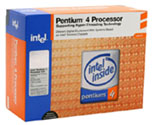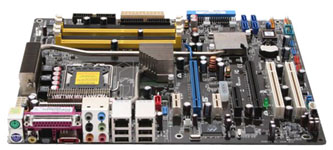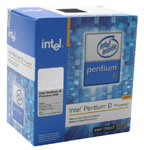Mid-Range to High-End Buyer's Guide, January 2006
by Jarred Walton on January 2, 2006 1:00 AM EST- Posted in
- Guides
Intel CPU and Motherboard Recommendations
Motherboards are just as important a component for Intel systems - possibly more so, as the lack of an integrated memory controller seems to create more variance in performance among Intel boards. The multi-GPU market for Intel systems is also more limited, as you have either NVIDIA's nForce4 SLI for Intel or Intel's own 975X, but the latter still hasn't shown up in reasonable quantities. ATI should be releasing an Intel CrossFire chipset at some point as well, but how soon that will make it to market is difficult to say. Then again, if gaming and multi-GPU configurations is your interest, there's no compelling reason to go with an Intel system right now. Higher temperatures, more noise, and lower performance for a typically higher price? That's a tough sell. Still, with the pending launch of Presler and the potential to overclock to 4.0 GHz and beyond with the proper setup, Intel systems aren't a lost cause. Personally, though, I would wait for Presler to launch before purchasing a new Intel system. Here are the current recommendations, if you're not willing to wait another month.
Intel Mid-Range Motherboard: ASUS 945P P5LD2 (775)
Price: $125 shipped
Intel Mid-Range CPU: Pentium 4 630 2MB 3.0GHz (775) - Retail
Price: $174 shipped (Retail)
Total: $299
If you're looking for a decent mid-range Intel system, the choice of processor has two good options. The first is to grab the cheapest Pentium D chip, the 820, and perhaps try your luck at overclocking. It costs a bit more, though, and not everything will benefit from multiple cores right now. We'll leave dual-cores for our high-end recommendation and stick with the slightly cheaper single-core Pentium 4 for now. Choosing between the 5xx and 6xx cores is still debatable, but the 630 comes with more cache and a slightly lower price than the 531, so we feel that it wins out.
The choice of motherboard is very difficult, as there are plenty of viable options. The best 945P/G boards actually cost more than many nForce4 SLI for Intel boards, but most of the lower end SLI boards have early revision chipsets that don't properly support the Pentium D 820 - they disable the second core. If you're sure you won't use a dual core chip in such a motherboard, they're still a good choice, but we would recommend taking the safer choice and going with an Intel chipset. The Intel chipset boards also overclock quite well, and SLI isn't a priority on a mid-range board. We've selected the ASUS 945P P5LD2, which is the "little brother" of the Deluxe board that we reviewed recently. It has good overclocking support and performance, and includes HD Azalia audio and GbE. Some of the other amenities like FireWire are missing, and the layout isn't perfect (particularly the floppy connector location, assuming you want to use a floppy), but overall it's a good board.
Intel High-End Motherboard: ASUS nForce4 SLI X16 (775) P5N32-SLI Deluxe
Price: $208 shipped
Intel High-End CPU: Pentium D 830 2x1MB 3.0GHz (775) - Retail
Price: $320 shipped (Retail)
Total: $528
For the ultimate in Intel systems, the choices are much more limited. Gigabyte's Quad Royal is not yet available (and will apparently cost a pretty penny when it hits the market), and the same can be said of 975X based motherboards. That leaves nForce4 SLI, and we went with the SLI-X16 board from ASUS. Our review found this to be the cream of the crop in the Intel enthusiast community, and it took our 840EE processor all the way to 4.1 GHz. It should also support the new Presler CPUs when they become available. Our processor choice echoes the high-end AMD pick: dual-core, moderately powerful, but don't break the bank just yet. Naturally, you can spend more money on a faster CPU (like the new 955EE) if you really want, but we would question the sanity of anyone spending $1000 just for a processor, particularly when such a part can't even sweep every benchmark. The good news is that the Intel "High-End" platform costs less than the AMD recommendation; unfortunately, the AMD is also clearly superior in performance, and not even the 955EE chip would close the gap.
Motherboard Alternatives:
If choosing a best product among AMD motherboards and processors is difficult, it's even worse in the Intel camp. Dual-core processor support is a must, even if you're not running a dual-core chip, so that means the 915/925 and earlier chipsets are out of contention. That still leaves plenty of 945G/P, 955X, nForce4 SLI, and soon-to-be-released 975X chipset boards to compare. 965 "Broadwater" boards will also launch some time in the next few months. You also have the pending launch of some new processors that may or may not work on anything but the latest 975X chipset, not to mention that Yonah and Conroe are due out next year and further complicate matters. While I don't expect the switch to socket M2 to have a major impact on AMD performance, I can't say the same for Conroe. It may match Athlon 64, it may beat Athlon 64, or it may not even match Presler. Based on Yonah performance, we can assume that Athlon 64 parity is likely, but the 4-issue core is difficult to assess without actual testing.
Anyway, you can see several alternative boards above that meet the minimum Pentium D compatibility requirement. If you're looking for a rock-solid stable motherboard, Intel's own boards like the D945PSNLK are always a safe choice. The SLI-ready boards may have issues with overclocking and/or Pentium D 820 support, as we mentioned previously, but they otherwise represent a reasonable alternative. While you may never need the second X16 slot, it certainly won't hurt to have the option, and you can always use an X1, X2, X4, or X8 card if something useful comes out with that connection type.
Motherboards are just as important a component for Intel systems - possibly more so, as the lack of an integrated memory controller seems to create more variance in performance among Intel boards. The multi-GPU market for Intel systems is also more limited, as you have either NVIDIA's nForce4 SLI for Intel or Intel's own 975X, but the latter still hasn't shown up in reasonable quantities. ATI should be releasing an Intel CrossFire chipset at some point as well, but how soon that will make it to market is difficult to say. Then again, if gaming and multi-GPU configurations is your interest, there's no compelling reason to go with an Intel system right now. Higher temperatures, more noise, and lower performance for a typically higher price? That's a tough sell. Still, with the pending launch of Presler and the potential to overclock to 4.0 GHz and beyond with the proper setup, Intel systems aren't a lost cause. Personally, though, I would wait for Presler to launch before purchasing a new Intel system. Here are the current recommendations, if you're not willing to wait another month.
 |
 |
| Click images to enlarge. | |
Intel Mid-Range Motherboard: ASUS 945P P5LD2 (775)
Price: $125 shipped
Intel Mid-Range CPU: Pentium 4 630 2MB 3.0GHz (775) - Retail
Price: $174 shipped (Retail)
Total: $299
If you're looking for a decent mid-range Intel system, the choice of processor has two good options. The first is to grab the cheapest Pentium D chip, the 820, and perhaps try your luck at overclocking. It costs a bit more, though, and not everything will benefit from multiple cores right now. We'll leave dual-cores for our high-end recommendation and stick with the slightly cheaper single-core Pentium 4 for now. Choosing between the 5xx and 6xx cores is still debatable, but the 630 comes with more cache and a slightly lower price than the 531, so we feel that it wins out.
The choice of motherboard is very difficult, as there are plenty of viable options. The best 945P/G boards actually cost more than many nForce4 SLI for Intel boards, but most of the lower end SLI boards have early revision chipsets that don't properly support the Pentium D 820 - they disable the second core. If you're sure you won't use a dual core chip in such a motherboard, they're still a good choice, but we would recommend taking the safer choice and going with an Intel chipset. The Intel chipset boards also overclock quite well, and SLI isn't a priority on a mid-range board. We've selected the ASUS 945P P5LD2, which is the "little brother" of the Deluxe board that we reviewed recently. It has good overclocking support and performance, and includes HD Azalia audio and GbE. Some of the other amenities like FireWire are missing, and the layout isn't perfect (particularly the floppy connector location, assuming you want to use a floppy), but overall it's a good board.
 |
 |
| Click images to enlarge. | |
Intel High-End Motherboard: ASUS nForce4 SLI X16 (775) P5N32-SLI Deluxe
Price: $208 shipped
Intel High-End CPU: Pentium D 830 2x1MB 3.0GHz (775) - Retail
Price: $320 shipped (Retail)
Total: $528
For the ultimate in Intel systems, the choices are much more limited. Gigabyte's Quad Royal is not yet available (and will apparently cost a pretty penny when it hits the market), and the same can be said of 975X based motherboards. That leaves nForce4 SLI, and we went with the SLI-X16 board from ASUS. Our review found this to be the cream of the crop in the Intel enthusiast community, and it took our 840EE processor all the way to 4.1 GHz. It should also support the new Presler CPUs when they become available. Our processor choice echoes the high-end AMD pick: dual-core, moderately powerful, but don't break the bank just yet. Naturally, you can spend more money on a faster CPU (like the new 955EE) if you really want, but we would question the sanity of anyone spending $1000 just for a processor, particularly when such a part can't even sweep every benchmark. The good news is that the Intel "High-End" platform costs less than the AMD recommendation; unfortunately, the AMD is also clearly superior in performance, and not even the 955EE chip would close the gap.
Motherboard Alternatives:
| Intel Motherboards | ||
| Class | Model | Price |
| Mid-Range | Gigabyte nForce4 SLI GA-8N-SLI Pro (775) | 116 |
| Mid-Range | Intel 945P D945PSNLK (775) | 117 |
| Mid-Range | MSI nForce4 SLI P4N SLI-FI (775) | 123 |
| Mid-Range | Abit nForce4 SLI NI8 SLI GR (775) | 138 |
| High-End | Abit 945P AL8 (775) | 146 |
| High-End | ASUS nForce4 SLI P5ND2-SLI Deluxe (775) | 158 |
| High-End | ASUS 945P P5LD2 Deluxe (775) | 163 |
| High-End | Abit 955X AW8 (775) | 170 |
| Ultra-High | ASUS 955X P5WD2 Premium (775) | 208 |
| Ultra-High | Gigabyte 955X GA-8I955X Royal (775) | 211 |
If choosing a best product among AMD motherboards and processors is difficult, it's even worse in the Intel camp. Dual-core processor support is a must, even if you're not running a dual-core chip, so that means the 915/925 and earlier chipsets are out of contention. That still leaves plenty of 945G/P, 955X, nForce4 SLI, and soon-to-be-released 975X chipset boards to compare. 965 "Broadwater" boards will also launch some time in the next few months. You also have the pending launch of some new processors that may or may not work on anything but the latest 975X chipset, not to mention that Yonah and Conroe are due out next year and further complicate matters. While I don't expect the switch to socket M2 to have a major impact on AMD performance, I can't say the same for Conroe. It may match Athlon 64, it may beat Athlon 64, or it may not even match Presler. Based on Yonah performance, we can assume that Athlon 64 parity is likely, but the 4-issue core is difficult to assess without actual testing.
Anyway, you can see several alternative boards above that meet the minimum Pentium D compatibility requirement. If you're looking for a rock-solid stable motherboard, Intel's own boards like the D945PSNLK are always a safe choice. The SLI-ready boards may have issues with overclocking and/or Pentium D 820 support, as we mentioned previously, but they otherwise represent a reasonable alternative. While you may never need the second X16 slot, it certainly won't hurt to have the option, and you can always use an X1, X2, X4, or X8 card if something useful comes out with that connection type.










67 Comments
View All Comments
Sceptor - Monday, January 2, 2006 - link
In keeping with the mid-range theme...why was the ASRock 939Dual not included??It has most of the features of the low end Asus and DFI boards...at a reduced cost.
You can even run AGP and PCI-E cards together...not SLI however.
JarredWalton - Monday, January 2, 2006 - link
I consider the ASRock firmly in the "budget" category, given the $75 or so price. I will be sure to mention it in the next budget guide, but personally I don't worry about AGP support on any new Mid-Range system. But yes, it's a reasonable board for the cost.JarredWalton - Monday, January 2, 2006 - link
To reiterate: those who know what they're doing can get the ASRock to work fine. However:Memory issues with some products
BIOS support lacking
Mediocre quality control
Probably some other stuff....
http://www.newegg.com/Product/CustRatingReview.asp...">Newegg reviews indicate that about 15% of people seem to have issues. I would spend more for a bit nicer board (meaning nF4 Ultra or ATI Xpress 200 CF) on anything more than a budget build.
justly - Monday, January 2, 2006 - link
I can understand why you would call the Asrock a budget board.Although I find it interesting that you would use the comments on Newegg as an indication that the Arock board has issues since the http://www.newegg.com/Product/CustratingReview.asp...">Newegg comments about the DFI nforce ultra infinity doesn't make your choice look to good.
In fact if you where to go by Neweggs comments the Arsock looks much better since the DFI indicates that about 50% of people seem to have issues with it.
JarredWalton - Monday, January 2, 2006 - link
Yeah, the DFI comments are all over the place. I have to say that I haven't seen much in the way of problems with the DFI Infinity. Basically, I'm doing a bit of reading between the lines. The chief complaints I'm seeing on the Infinity amount to "it's not a LanParty". I guess after running several CPUs and RAM types from stock settings all the way up through massive overclocks, I have trouble thinking that it's as bad as the Newegg reviews are saying - well, some of them anyway.Reading between the lines on the ASRock, the chief thing seems to be "OMG it has working AGP and PCIe!" Which is fine if you really have an AGP card that you like, but considering the best AGP cards can be equaled (usually) for around $200 now, it's not a huge issue. If I had a good system with an AGP card, I'd either live with it a while longer, or move it to a secondary role (or sell it) and get new components, you know? Six months ago, this board made a lot more sense; today, AGP is just 6 months older, while PCIe has two whole product lines you can't get on AGP.
Bleh. Let's just call it writer bias and be done with it. Like I always say, get what you like. My picks are merely some reasonable choices as I see it. :)
TowerShield - Wednesday, January 4, 2006 - link
Of course, that board still has that "OMG this board will support the AM2 socket" with it as well that will keep it going until right into the first year of AM2 MBs.Sceptor - Monday, January 2, 2006 - link
Presumably those who read this site will "know what they are doing"...Seeing as most readers here have grown up with computers. Just my 2 cents...Thanks for the replies..
Calin - Tuesday, January 3, 2006 - link
Nobody wants "free" problems - and when I bought my mainboard long time ago, I looked in just one more place except anandtech.comOrSin - Monday, January 2, 2006 - link
Fix the ram price and put in another pair.I did the same thing looking for where i could find it for $150
JarredWalton - Monday, January 2, 2006 - link
Corrected - see note above. The RAM name was linked, and the last page had it right. You can't even find generic 2x1GB DDR for $150; sorry to get your hopes up. :(